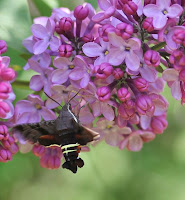 |
| Female Io - Automeris io moths, are as large as the sphinx! |
I've managed to photograph both the Io caterpillar and moth. A tricky job, I can tell you.
 |
| Io caterpillar |
 |
| Io moth with closed wings, fabulous eyes on the underwing |
The largest I've photographed was the Imperial moth. It was resting one summer morning last year, on our cedar rail fence right beside the house. More common are the sphingidae or sphinx moths.
Feeding at night
 |
| Large, Imperial moth |
 |
| Io eating my Hops plant leaves! |
Most, the Peterson Field Guide says, are nocturnal and are drawn to the lights.
Two nights ago we managed photos of this friendly sphinx, as well as a baby gray tree frog and a firefly.
Moth identification
I use the BAMONA website, staffed by volunteers, experts who help me identify the moths and butterflies. There are so many about.
More than 11,000 moths alone, with my Peterson Field Guide to Moths of Northeastern North America IDing only 1500. It does help when you understand the difference between a Silk moth, an underwing, and a sphinx!
Trapping Moths
 |
| Lovely markings on the sphinx |
Moth bait
Some moths understand that lights are fake, and you'll need nectar to attract them.
One mixture consists of:
- a soft banana
- a scoop of brown sugar
- a dollop of molasses,
- a glug or two of beer.
Paint this on a tree, or on a thick rope strung between supports. Watch out for the raccoons, though! Check it regularly.
Photographing moths
 |
| Imperial moth body is the diameter of my finger |
They also say to put the moth in the fridge for one night to cool it down, making it slower and easier to photograph in natural daylight. They get into a state of torpor, calms them and lowers their metabolism.
Sphinx moths
 |
| White-lined sphinx on phlox |
This sphinx seemed to quite adore us!
They are quite impressive, as you can see from the photos. The Hummingbird clearwing is the smaller of this species. It is often called a hummingbird moth.
Their bodies, as my field guide says, are 'robust!' They come to a point.
 |
| Sphinx are all over the place |
Narrow wings (e.g., Great ash sphinx), or some, like the Blinded sphinx, have irregular wings, almost like tatted lace. The Blinded sphinx photo below shows the pretty colour in the underwing.
Here are some of the other sphinx moths I have photographed!
 |
| Sphinx chersis Great ash sphinx |
 |
| Hummingbird clearwing moth! One of the diurnal moths |
 |
| Leggo!!!! |
 |
| Xylophanes tersa Tersa Sphinx A great, long proboscis |
 |
| Blinded sphinx underwing |
 |
| Paonias excaecata Blinded sphinx |
 |
| Bipectinate antenna; fuzzy wuzzy basal area! |
 |
| Clearwing in spring on lilac |
5 comments:
don't get moths like that in the UK
Great stuff. We miss a lot by not sitting quietly in the night.
Hari OM
OMGosh Jenn, these are simply delightful. I have always had a thing for bugs of all sorts and am thrilled to find another - lady! - with an equal passion!! The Froglet and Firefly were also impressive.
...I would hesitate to put any creature into the refrigerator however, other than for life preservation purposes! Thanks for all the perfect peeks. YAM xx
Thanks for educating me so much about moths and moth photography. Another whole new set of possibilities!
Oh wow, these are amazing! Truly spectacular moths.
Post a Comment